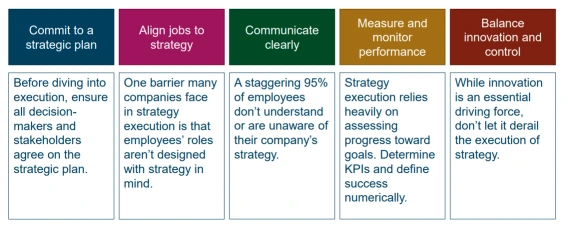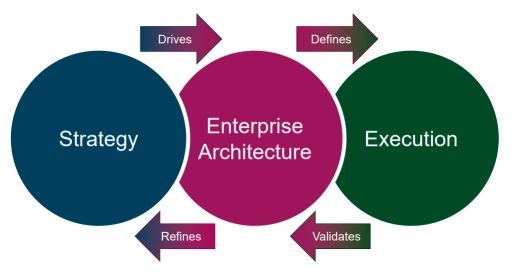A lot of organisations are struggling with their strategy; more specifically, they are struggling with the translation of their strategy to its execution. Making sense of strategy is challenging.
Last month, I presented a webinar, ‘Making sense of strategy‘, during which I showed the audience how one can get from strategy to execution by using real-world examples. For those interested, you can listen to and watch the webinar by following this link.
Nothing new
The approach to getting from strategy to implementation is not new. In fact, it has been around for nearly 20 years. Admittedly, it has become more and more mature over the aforementioned two decades, starting with the release of the TOGAF 8 Enterprise Edition in 2003.
With the release of the 8th edition of the framework, the Architecture Development Method (or ADM) was being applied to the business, data and application layers, as well as the original technology layer. This allowed the framework to span enterprise-wide and thus made it possible to cope with an organisation’s strategy.
Definition of strategy
As with all things in architecture, it all starts with a definition. Definitions are important because it allows you, or an organisation, to speak the same uniform language. The definition of strategy is no exception to this.
There are many definitions of the word and agreeing on one is essential. Take Merriam-Webster for instance. The dictionary defines strategy as “a careful plan or method”. Gartner, on the other hand defines strategy as “a plan designed to guide the achievement of specific objectives”. My personal favourite is the WikiPedia definition of the word strategy.
Strategy is the determination of the basic long-term goals of an enterprise, and the adoption of courses of action and the allocation of resources necessary for carrying out these goals.
WikiPedia
Needless to say that aside from the definition of strategy, it is equally important to use an unambiguous definition for drivers, goals and principles.
From strategy to execution
Over the years, a lot has been written regarding the journey from strategy to execution. When you look more closely at the information available, you’ll notice that five themes tend to surface over and over again. These themes can be seen as the five pillars of strategy execution.

Pillar 1: Commit to a strategic plan
First and foremost, the organisation must ensure that there is agreement on the strategic plan. Without that, the organisation will not succeed in implementing its strategy. It is important that all stakeholders are looking in the same direction before we can start implementing the strategy.
Pillar 2: Align jobs to strategy
People are needed to execute the strategy and it is necessary that these people hold a position that enables them to do so. So think carefully in advance about whether employee roles are sufficiently designed with the company’s strategy in mind. Just as it does not make sense to ask a car mechanic to fly an aeroplane, it does not make sense to deploy people with a job description that does not match the chosen strategy.
Pillar 3: Communicate clearly
Research has shown that about 95% of the employees do not fully understand what the strategy of their own organisation entails and what it means for them. A large group of employees do not even know the strategy exists. This is a serious problem. In my opinion, every employee should be familiar with an organisation’s strategy. Not every employee will be able to fathom a strategic plan right away, and therefore it is important to formulate this strategic plan in such a way that every employee can recognise him- or herself in it. Knowing in which way employees can contribute to the course of the organisation ensures a much better adoption of the strategy.
Pillar 4: Measure and monitor performance
It is impossible to monitor progress of strategy implementation if the goals are not measurable. By using measurable objectives or KPIs, one can prevent that management teams look at each other expectantly during quarterly meetings without being able to clearly report on progress.
Pillar 5: Balance innovation and control
Yes, innovation matters. But never let it derail the execution of strategy. Innovation should be part of the strategy, but the control of the operations should not be lost sight of. Reserve an appropriate amount of space for innovation for the organisation, but don’t overdo it.
The connecting element
So, how do we get from strategy to execution? This may not come as a very big surprise but the connecting element between strategy on the one hand and implementation on the other is, of course, Enterprise Architecture.

The reason for this is that strategy drives the Enterprise Architecture. EA in its turn defines the execution of the strategy.
Going the other way, we see that the execution validates the Enterprise Architecture and that EA refines the strategy.
Visualising strategy
One final key element in getting from a strategic plan to a succesful execution is making sure that the content of the plan stays visible at all times.
It is very tempting to practise Enterprise Architecture in its fullest form. A word of warning though: this causes the visibility of the originally drafted strategy to fade into the background. It will be overshadowed by the exhaustiveness of the architecture framework and all its elements.
In order to not lose the most essential stakeholders (the ones who came up with the organisation’s strategy), you should make sure that the vision of its creators is visible at all times. This will mean adjusting and/or tailoring the architecture framework and modelling language.
Doing so will result in a far better adoption of Enterprise Architecture.
Conclusion
So, in order to get from strategy to its execution, be sure to use clear definitions, stick to the five pillars of strategy execution, apply Enterprise Architecture tailor-made and never lose sight of the original vision when visualising strategy. Easy as one-two-three.







Leave a Reply